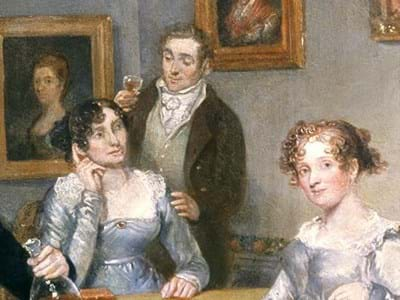Style, taste and identity
The things we choose to fill our homes with can define who we are and how we are seen by others. These choices are often driven by individual taste or need.
Our choices are, however, also heavily influenced by social codes, fashions and behaviours.

Family portrait
In the late 1700s the way people decorated and furnished their parlour changed dramatically.
It became a canvas for people with disposable income to express their good taste and social standing.
The homeowners here are letting their home convey their educated tastes and cultural attitudes.
The room is full of good quality objects – neoclassical style ornaments, paintings, a gilded mirror – all of which are meant to impress the guests.
Group portrait of a family in a domestic interior. Unknown artist, about 1815–1820


Utility chair
This chair was made for the Utility Furniture scheme, which ran from 1942 to 1953.
Timber was scarce during the war, and the Utility Furniture scheme was a result of war-time rationing.
The scheme was led by the modernist design ideology that good design could improve people’s lives. It aimed to raise the standard of furniture for the everyone and have a beneficial influence on public taste.
The unauthorised decoration on the backrest is an example of our wish to personalise the objects in our homes.
Utility chair, 1943–1948

Portrait of sisters
Isobel (seated) was fourteen and her sister Dorothy (standing) was eight years old when this portrait was painted.
From about 1860 to 1900, a new 'artistic' style revolutionised interior design and changed people's idea of what was good and bad taste.
The family's artistic ideals are shown here through their choice of furnishings, in the loose-fitting style of dress worn by the two girls, and in the depiction of Dorothy holding a violin. Being 'artistic' was not just about your possessions but also shown through your lifestyle.
It was a time when people were more closely associated with their possessions, your style became a way of defining yourself.
Portrait of Bell and Dorothy Freeman, Edward Robert Hughes, 1889

Porcelain ornaments
This matching set of jugs and a vase are made in a classical style. The shapes follow those of classical urns, while the painted panels depict classical figures and landscapes. Known as a garniture, a set like this would have been displayed on a mantelpiece or side table.
From the 1760s neoclassical style became popular in the design of homes and furnishings. This was inspired by ancient Greek and Roman art and architecture. It emphasised delicacy, simplicity and symmetry, in keeping with 'neat' elegance. Urns, vases and columns were common motifs.
Porcelain ornaments, about 1782

